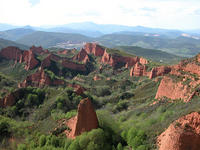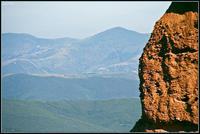You are in: Europe -> Spain -> Las Médulas, and traditional search or Image Gallery will yield results of this site only
Las Médulas
| Site number: | 803 |
|
| Type of site: | Cultural | |
| Date: | 1st century AD | |
| Date of Inscription: | 1996 | |
| Location: | Europe, Spain, Province of Léon, Autonomous Community of Castile-Leon | |
Up to 75 images are shown here. Click on each for more details or on Image Gallery for more images.
| Description: | The exploitation of the gold deposits of this region in north-west Spain commenced in the 1st century A.D. by the Roman Imperial authorities using a method based on hydraulic power. The Romans vacated the deposits after two centuries of working there, leaving behind a ravaged landscape. Given that no subsequent industrial activity took place, the dramatic remnants of this incredible early technology are evident all over the site as sharp faces in the mountainsides and the immense areas of tailings, currently used for agriculture. --WHMNet paraphrase from the description at WHC Site, where additional information is available. | |
| Las Médulas, located near the town of Ponferrada in León province, Spain, used to be the most important gold mine in the Roman Empire. Las Médulas Cultural Landscape is listed by the UNESCO as one of the World Heritage Sites. The spectacular landscape of Las Médulas resulted from the Ruina Montium, a Roman mining technique described by Pliny the Elder consisting in the perforation of the mountain and latter irruption of great quantities of water that literally pulled the mountain down, a precedent of Californian hydraulic mining. To bring the necessary water from the Sierra de La Cabrera mountains to Las Médulas a system of channels more than hundred kilometers long was constructed, and some of its portions are still conserved. Description of Las Médulas in Pliny the Elder's Natural History: "What happens in Las Medulas is far beyond the work of giants. The mountains are bored with corridors and galleries made by lamplight with a duration that is used to measure the shifts. For months, the miners cannot see the sunlight and many of them die inside the tunnels. This type of mine has been given the name of Ruina Montium. The cracks made in the entrails of the stone are so dangerous that it would be easier to find purpurine or pearls at the bottom of the sea than make scars in the rock. How dangerous we have made the Earth!" Pliny also stated that 20,000 Roman pounds of gold were extracted each year. The exploitation, involving 60,000 free workers, brought 5,000,000 Roman pounds (1,650,000 kg) in 250 years. --Wikipedia. Text is available under the Creative Commons Attribution-ShareAlike License. | ||
| Source: | http://whc.unesco.org/en/list/803 | |
| Reference: | 1. UNESCO World Heritage Center, Site Page. | |
















